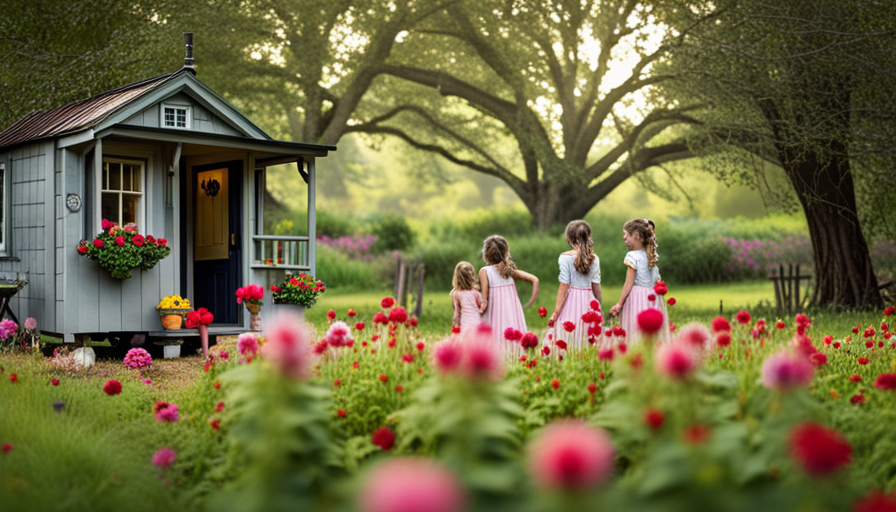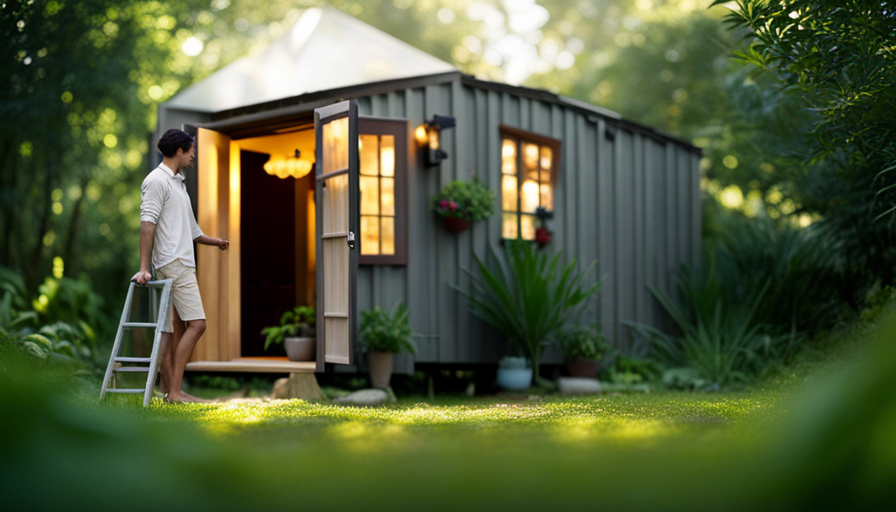While living in a small house with seven or eight children, chaos reigned daily. The atmosphere was filled with happiness, arguments, and constant mess everywhere. Despite the cramped space, our home was full of love, energy, and memories that have shaped the person I am today.
Living in a cramped space taught me invaluable lessons about the bond of sibling relationships and the art of compromise. We learned to navigate the challenges of sharing and respecting personal space, all while building resilience and independence. Our home may have lacked privacy, but it overflowed with a sense of togetherness and camaraderie that cannot be replicated.
In this article, we will explore the trials and triumphs of growing up in a crowded home. From the importance of organization and routine to the creation of lasting memories and traditions, we will delve into the lessons and values that were instilled in us during those formative years.
So, buckle up and get ready for a trip down memory lane as we reminisce about the days when a tiny house held a big, beautiful family.
Key Takeaways
- Sibling relationships and compromise: Growing up in a crowded house with seven or eight kids taught the importance of navigating relationships with siblings and finding compromise in order to maintain peace and harmony.
- Resilience and independence: The challenges of living in a tiny house fostered resilience and independence, as children had to learn to adapt and find their own ways of navigating the limited space and chaotic environment.
- Importance of organization and routine: With belongings everywhere and constant chaos, it became crucial to establish organization and routine to create order and prevent feeling overwhelmed and cramped in the small living space.
- Cherishing family moments and building resilience: Despite the lack of privacy and space, growing up in a crowded home instilled the importance of cherishing family moments, building resilience, and finding joy in simple things such as laughter, shared meals, and family gatherings.
The Bond of Sibling Relationships
You and your siblings were like a tightly-knit bunch of wildflowers, swaying and blooming in harmony despite the cramped quarters of our tiny house. Sibling rivalry and conflict resolution were common occurrences, as we jostled for space and attention. However, these challenges only served to strengthen our bond.
We learned valuable lessons in compromise, negotiation, and empathy, as we navigated the intricate dynamics of our large family. Through countless disagreements and arguments, we developed the art of conflict resolution, understanding that compromise was essential for a peaceful coexistence. This ability to resolve conflicts has been invaluable in my personal development, as it has equipped me with the skills needed to navigate through various relationships and situations in life.
Growing up in a house filled with siblings had a profound impact on my personal development. The constant companionship and interaction with my brothers and sisters taught me the importance of communication, patience, and understanding. We learned to share, to wait our turn, and to respect each other’s boundaries. Our sibling relationships provided a support system that shaped our characters and helped us grow into resilient individuals.
Transitioning into the subsequent section about embracing the chaos of a full house, I realized that our upbringing in a tiny house with seven or eight kids taught us the value of embracing the chaos and finding joy in the midst of it all.
Embracing the Chaos of a Full House
Immersing yourself in the lively atmosphere of a bustling household with a large number of children can be an exhilarating experience. The chaos, the noise, and the constant activity can be overwhelming at times, but there’s also a certain beauty in it all.
It’s in the chaos that you find moments of pure joy and laughter, where the love between siblings shines through. It’s in the chaos that you learn to appreciate the little things, like a quiet moment alone or a simple act of kindness.
Finding balance in a full house is a constant challenge. It requires patience, understanding, and a willingness to let go of control. You have to embrace the chaos and accept that not everything will go according to plan. But in doing so, you discover a sense of freedom and spontaneity that’s hard to find elsewhere. You learn to go with the flow and adapt to whatever comes your way.
In a house filled with so many people, space becomes a precious commodity. But instead of feeling confined, we learned to make the most of our limited space. We found creative ways to maximize every inch, whether it was through bunk beds, storage solutions, or creating designated areas for different activities. It taught us the value of simplicity and the importance of making the most of what we have.
Transitioning into the next section about ‘making the most of limited space’, we realized that our small house forced us to be resourceful and creative in finding ways to accommodate everyone’s needs.
Making the Most of Limited Space
Embracing the chaos of a full house, I quickly discovered the art of making the most of limited space. With seven or eight kids crammed into a tiny house, maximizing functionality was crucial. We had to get creative with our storage solutions to ensure that every inch of space was utilized efficiently.
One of the first things we did was invest in multi-purpose furniture. Beds with built-in drawers provided extra storage for clothing and toys, while ottomans doubled as seating and hidden storage. We also utilized vertical space by installing shelves and hanging organizers on the walls. This allowed us to keep the floor clear and create more room for activities.
Another key strategy was decluttering regularly. With so many people in a small space, it was important to keep things organized and minimize excess belongings. We would regularly go through our possessions, donating or selling items we no longer needed. This helped to create a sense of order and prevented the house from feeling too cramped.
Transitioning into the next section about learning to share and compromise, we realized that living in a small house required us to work together as a team. Learning to share our limited space and resources taught us the value of compromise and the importance of considering others’ needs.
Learning to Share and Compromise
Transitioning into the next section, we quickly learned the importance of sharing and compromising while living in a small, cramped space. Teaching cooperation became a necessity as we had to find ways to peacefully coexist with seven or eight siblings under one roof. Fostering empathy was crucial in understanding each other’s needs and finding common ground.
-
Shared Responsibilities: We divided household chores among ourselves, creating a sense of teamwork. Each of us had specific tasks assigned, which taught us the importance of contributing to the household and working together towards a common goal.
-
Respecting Personal Space: Living in a tiny house meant limited privacy. We learned to respect each other’s boundaries and find ways to carve out personal space within the cramped quarters. This helped us understand the value of personal boundaries and the need to accommodate others.
-
Negotiation and Compromise: With so many people living in close proximity, conflicts were inevitable. Learning to negotiate and compromise became essential skills. We had to find ways to resolve disputes peacefully, understanding that sometimes we needed to give up our own desires for the greater good of the family.
Transitioning into the subsequent section about the importance of organization and routine, we realized that maintaining order and structure in our daily lives was essential for harmonious living in our small space.
The Importance of Organization and Routine
Establishing a sense of order and following a consistent routine were crucial for maintaining a harmonious and organized life in our cramped living space. With seven or eight kids under one roof, time management strategies became essential to ensure that everyone’s needs were met and chaos was kept at bay.
To maintain a peaceful and harmonious environment, we implemented a strict schedule that dictated everything from meal times to chores and bedtime routines. This not only helped us stay on track but also taught us the value of discipline and responsibility. Each child had assigned tasks and responsibilities, which fostered a sense of ownership and contributed to a smoothly running household.
Time management strategies were also employed to ensure that everyone had their fair share of attention and resources. We learned to prioritize and take turns, understanding that compromise was necessary for the greater good of the family. This taught us valuable life skills such as patience, empathy, and cooperation.
By adhering to a routine and managing our time effectively, we were able to create a sense of order and structure in our tiny house. It may have been challenging at times, but the rewards were immense.
As we transition into the subsequent section about finding joy in the simple things, it is clear that the foundation of organization and routine laid the groundwork for a fulfilling and contented life.
Finding Joy in the Simple Things
Despite the challenges we faced, we discovered that the simple pleasures in life brought us the greatest joy. Living in a tiny house with seven or eight kids meant that we had to find contentment in minimalism. We didn’t have a lot of material possessions, but we learned to appreciate the beauty in simplicity.
Instead of fancy toys, we played with sticks and rocks, using our imaginations to create endless adventures. We found delight in the sound of laughter and the warmth of family gatherings. Our small living space encouraged us to spend more time outdoors, exploring nature and discovering the wonders of the world around us.
In those moments, we realized that happiness doesn’t come from material possessions or extravagant experiences. It comes from finding joy in the simple things, like a beautiful sunset or a heartfelt conversation. We learned to embrace the small moments that made life meaningful, like sharing meals together or reading stories before bed. These simple acts created lasting memories and traditions that we still cherish to this day.
As we reflect on those years, we recognize the value of finding contentment in minimalism and appreciating the beauty in simplicity. It taught us to focus on what truly matters and to live in the present moment. By letting go of the need for excess, we were able to cultivate a sense of gratitude and find happiness in the little things.
Creating Lasting Memories and Traditions
Immerse yourself in a world of cherished memories and timeless traditions that will forever warm your heart and bring a smile to your face. Growing up in a tiny house with seven or eight siblings meant that we had to find creative ways to create new traditions and cherish our family moments. Despite the challenges of limited space, we managed to build lasting memories that have become a significant part of who we are today.
One of our favorite traditions was our weekly family game night. Every Friday evening, we would gather around the kitchen table, laughing and competing in various board games. It was a time when we could forget about our cramped living conditions and simply enjoy each other’s company. These game nights not only allowed us to bond as a family but also taught us important values such as sportsmanship and teamwork.
Another cherished tradition was our annual camping trip. We would pack up our tiny house on wheels and head to a nearby campground, escaping the hustle and bustle of everyday life. Camping gave us the opportunity to reconnect with nature and each other. We would spend our days hiking, fishing, and telling stories around the campfire. These moments created a sense of unity and adventure that we carry with us to this day.
As I reflect on these traditions, I realize the importance of cherishing family moments. They provided a sense of stability and love amidst the chaos of our crowded living situation. These traditions not only created lasting memories but also taught us the value of togetherness and resilience.
As we transition into the subsequent section about building resilience and independence, we can see how these traditions laid the foundation for our ability to overcome challenges and thrive in the face of adversity.
Building Resilience and Independence
To truly thrive and grow, you must cultivate your resilience and independence, navigating life’s challenges with unwavering strength.
Growing up in a tiny house with seven or eight siblings was not always easy, but it taught me valuable lessons in building self-confidence and problem-solving skills.
Living in a small space meant that privacy and personal space were often scarce, forcing us to find ways to coexist harmoniously. This required us to communicate effectively, compromise, and respect each other’s boundaries. Through these experiences, I learned to assert myself and build the self-confidence necessary to navigate the world beyond our small home.
Furthermore, the limited resources in our tiny house meant that we had to be resourceful and creative in finding solutions to everyday problems. Whether it was fixing a leaky faucet or coming up with games to entertain ourselves, we learned the importance of critical thinking and problem-solving skills. These skills have continued to serve me well throughout my life, enabling me to face challenges head-on and find innovative solutions.
As I reflect on my upbringing, I realize that the challenges we faced in our tiny house were instrumental in shaping the resilient and independent person I am today. Navigating the challenges of privacy and personal space was just one step in a lifelong journey of personal growth and development.
Navigating the Challenges of Privacy and Personal Space
In your small and bustling living quarters, it was a constant dance of finding balance between your need for privacy and the closeness of your family. Establishing boundaries became essential in navigating the challenges of privacy and personal space. We learned to communicate our needs clearly and respectfully, carving out pockets of alone time amidst the chaos.
Here are a few strategies we employed:
-
Setting physical boundaries: We designated certain areas as personal spaces, whether it was a corner of the room or a specific chair. This allowed each of us to have a small sanctuary within the shared living space.
-
Establishing quiet hours: We agreed upon specific times where noise levels were minimized, giving everyone a chance to recharge and have some peaceful moments.
-
Creating schedules: We implemented a system where each family member had designated time slots for personal activities or hobbies, ensuring that everyone had an opportunity for uninterrupted alone time.
-
Encouraging open communication: We fostered an environment where we could openly express our need for privacy without judgment or resentment.
Finding alone time in a crowded house required creativity and compromise. However, these experiences taught us invaluable lessons about respecting personal boundaries and the importance of communication. These lessons and values learned from growing up in a crowded home shaped us into resilient individuals who value both independence and the bonds of family.
The Lessons and Values Learned from Growing Up in a Crowded Home
Growing up in a bustling and close-knit household taught me invaluable lessons about the importance of respecting personal boundaries and fostering open communication. Living in a tiny house with seven or eight kids meant that privacy was scarce, and personal space was a luxury. However, this challenging environment taught me how to overcome adversity and develop strong interpersonal skills.
In a crowded home, it was crucial to find ways to carve out moments of solitude and respect each other’s need for personal space. We learned to communicate openly about our boundaries and find compromises that allowed us to coexist harmoniously. This experience taught me the importance of empathy and understanding, as we all had to navigate the challenges of living in such close quarters.
Growing up in a crowded home also taught me the value of teamwork and cooperation. We had to work together to keep our living space organized and functional. From sharing chores to problem-solving, we learned how to collaborate effectively and support one another. These skills have been invaluable in my personal and professional life, as they’ve helped me build strong relationships and navigate difficult situations.
Overall, growing up in a crowded home taught me important life lessons. It taught me how to overcome adversity, develop strong interpersonal skills, and appreciate the value of personal boundaries and open communication. These lessons have shaped me into the person I am today, and I’m grateful for the experiences I had in that tiny house with my siblings.
Frequently Asked Questions
How did you manage to fit everyone in such a small space?
I managed to fit everyone in our small space by using creative storage solutions and maximizing every inch. I also focused on creating a sense of belonging by involving everyone in the organization and design of our living space.
What were the biggest challenges you faced raising such a large family in a tiny house?
The biggest challenges I faced raising such a large family in a tiny house were managing daily routines and finding creative storage solutions. It required careful planning and organization to ensure everyone had their own space and that our daily lives ran smoothly.
Did your children ever feel overwhelmed or struggle with not having their own personal space?
My children did feel overwhelmed at times and struggled with not having their own personal space. However, we overcame these challenges by finding creative solutions, such as creating designated areas for each child and implementing a rotating schedule for sharing rooms.
How did you maintain a sense of order and organization in a crowded home?
To maintain order and stay organized in a crowded home, I implemented strict routines and created designated spaces for each child’s belongings. I also encouraged regular clean-ups and taught my children the importance of respecting shared spaces.
What lessons or values did you learn from growing up in a crowded home that have shaped your life today?
Lessons learned from growing up in a crowded home have had a significant impact on my relationships. I learned the importance of patience, compromise, and empathy, shaping my ability to connect and understand others.
Conclusion
In conclusion, growing up in a tiny house with 7 or 8 siblings was like dancing in a crowded room, where every step had to be carefully orchestrated.
It taught me the beauty of sibling bonds, the art of compromise, and the importance of organization.
Though the lack of personal space was challenging, it built resilience and independence within me.
Looking back, those chaotic days were the foundation for lasting memories and valuable life lessons.
Hi, I’m Emma. I’m the Editor in Chief of Tiny House 43, a blog all about tiny houses. While tree houses are often associated with childhood, they can be the perfect adult retreat. They offer a cozy space to relax and unwind, surrounded by nature. And since they’re typically built on stilts or raised platforms, they offer stunning views that traditional homes simply can’t match. If you’re looking for a unique and romantic getaway, a tree house tiny house might just be the perfect option.










